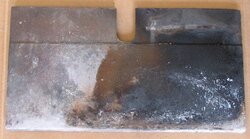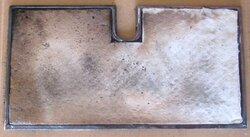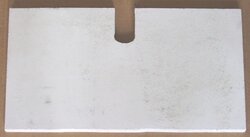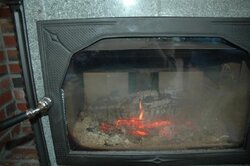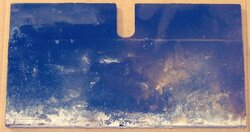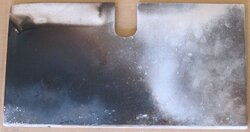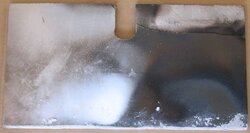From some discussion in another thread, I thought it might be useful to take a look at the various materials that are used to line woodstove fireboxes. There are basically four that I know of: Cast iron, dense firebrick (the heavy, yellow ones used in most pre-EPA stoves), porous firebrick (the lightweight ones used in some modern stoves), and Vermiculite panels (such as Skamol, used in many European stoves).
What these materials have in common is that they are, more or less, rugged enough to withstand the temperature swings (called thermal shock) and survive having wood jammed into them from time to time (mechanical shock).
What differs greatly is how readily heat passes through them. The measure of this is called Thermal Coefficient, K for short. A high K says the material readily collects and stores heat. A low K says the material is a good insulator, and resists the flow of heat through it.
Here is the thermal coefficient of these materials at 1000ºF per inch of thickness:
Cast iron : 150+ (from 55 at 200Fº)
Firebrick (heavy, yellow) : 14 (5.5 for a typical 2.5" thick brick)
Firebrick (light, insulating) : 1.1 (0.88 for a typical 1.25" thick brick)
Skamol V-1100 Vermiculite slab : 1.10 (slabs are typically 1" thick)
As you can see, cast iron and the heavy firebricks are poor insulators. It's no coincidence that they were widely used in pre-EPA stoves, when designers were trying to pull as much heat as they could OUT of the firebox. The lightweight firebrick is the better insulator by far, with the vermiculite a close second. And while all of them lose some of their insulating value as temps increase, cast iron is the worst, increasing by three times. No wonder it warps.
So if you want clean combustion AND high efficiency, you want a stove that uses the light firebricks.
Here's an excerpt from an article titled "The Straight Facts Concerning Refractories" by a company who designs and builds gas-fired forges:
Ceramic Blanket, Ceramic Fiberboard and Lightweight Insulating Firebrick are classified as Insulation, while Dense Ceramic Firebrick is NOT.
The insulating refractories have Low Thermal Conductivity, which means heat does not readily pass through them. The heat is reflected back into the chamber instead, creating a super efficient firebox.
Dense Ceramic Firebrick on the other hand, has a High Thermal Conductivity, which means heat readily passes through it, instead of "insulating" the chamber, it acts as a heat sink, absorbing heat and radiating it off through the shell. Dense Ceramic Firebrick, by it's very nature, ROBS a Forge of valuable heat. It's cheap and a very poor choice as a liner material.
What these materials have in common is that they are, more or less, rugged enough to withstand the temperature swings (called thermal shock) and survive having wood jammed into them from time to time (mechanical shock).
What differs greatly is how readily heat passes through them. The measure of this is called Thermal Coefficient, K for short. A high K says the material readily collects and stores heat. A low K says the material is a good insulator, and resists the flow of heat through it.
Here is the thermal coefficient of these materials at 1000ºF per inch of thickness:
Cast iron : 150+ (from 55 at 200Fº)
Firebrick (heavy, yellow) : 14 (5.5 for a typical 2.5" thick brick)
Firebrick (light, insulating) : 1.1 (0.88 for a typical 1.25" thick brick)
Skamol V-1100 Vermiculite slab : 1.10 (slabs are typically 1" thick)
As you can see, cast iron and the heavy firebricks are poor insulators. It's no coincidence that they were widely used in pre-EPA stoves, when designers were trying to pull as much heat as they could OUT of the firebox. The lightweight firebrick is the better insulator by far, with the vermiculite a close second. And while all of them lose some of their insulating value as temps increase, cast iron is the worst, increasing by three times. No wonder it warps.
So if you want clean combustion AND high efficiency, you want a stove that uses the light firebricks.
Here's an excerpt from an article titled "The Straight Facts Concerning Refractories" by a company who designs and builds gas-fired forges:
Ceramic Blanket, Ceramic Fiberboard and Lightweight Insulating Firebrick are classified as Insulation, while Dense Ceramic Firebrick is NOT.
The insulating refractories have Low Thermal Conductivity, which means heat does not readily pass through them. The heat is reflected back into the chamber instead, creating a super efficient firebox.
Dense Ceramic Firebrick on the other hand, has a High Thermal Conductivity, which means heat readily passes through it, instead of "insulating" the chamber, it acts as a heat sink, absorbing heat and radiating it off through the shell. Dense Ceramic Firebrick, by it's very nature, ROBS a Forge of valuable heat. It's cheap and a very poor choice as a liner material.



